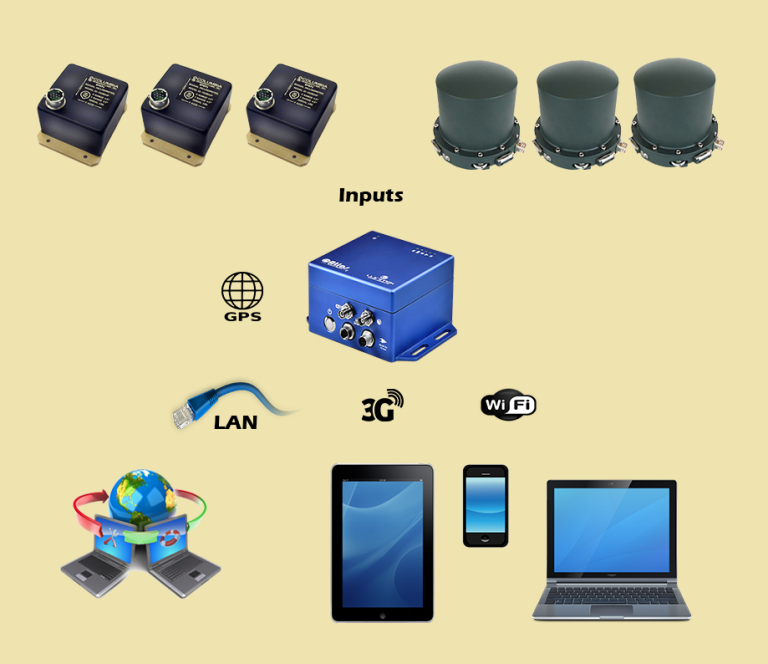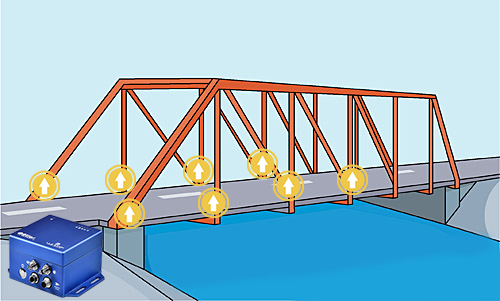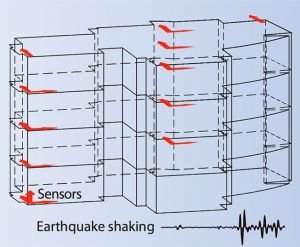

ATLAS-F is a variant of the ATLAS digitizer that was designed following a customer’s request. Compared to standard ATLAS it offers accessible/removable SD and SIM card slots, hot-swappable dual-slot batteries and the repositioning of all the connectors on one side.
The ATLAS-F is easily transportable in flights, the user can take out the batteries and transport them in the cabin. In addition, the dual battery slot is also useful when ATLAS-F is used for long-term monitoring as the batteries can be replaced one by one without turning off the instrument.
The purpose of positioning the connectors on one side is that the cables are easier to keep in order when the instrument is installed in a box and to save space.
ATLAS-F is available with 3,6 or 9 differential input channels for external sensors.
The instrument is equipped with high-resolution delta-sigma 24bit ADCs, all the channels are synchronized and the sample rate is adjustable up to 1000 sps per channel. The internal memory (up to 1TByte) has two independent recording zones: the ring-buffer zone which is dedicated to continuous sampling, and the triggering zone which is used for event sampling.
The data format is MiniSEED.
The built-in GNSS receiver synchronizes the system clock with the absolute time so that a network of several units can be created where all the channels are synchronized.
You can control ATLAS-F locally via network connection (LAN or WiFi), and remotely using the integrated 4G modem (optional). The SIM card is in micro format which is accessible to the user from the top panel.
Thanks to SeedLink protocol ATLAS-F is compatible with most popular seismic analysis software (Seiscomp3, Antelope, Earthworm).
The large capacity internal back up battery guarantees long term recording in the absence of an external power supply (typically 40hrs). This feature is greatly appreciated by customers because it is like having an integrated UPS, which saves space and money; both the 4G modem and the external sensors’ power supply is backed up by the internal battery.
The power supply ranges from 9 to 28 Volt DC and it can be connected to the electric power network using the power supply adapter included.
ATLAS-F can also be connected directly to a solar panel.
The anodized aluminum (INOX AISI316 option) enclosure is CNC milled, shockproof, vibration-resistant weather-resistant IP67.
| ATLAS-F |
|---|
| ADC resolution 24 bit |
| Dynamic range > 136dB@100 sps |
| Sampling rates 1, 20, 25, 50, 100, 200, 250, 500 , 1000 sps synchronous |
| Lan, Wi-fi and 4G modem |
| Built-in GNSS receiver |
| Integrated Ups, 40hrs system autonomy |
| Miniseed Data Format |
| Compatibility with Earthworm, Seiscomp, Geopsy, Seisgram2k |
ATLAS-F is designed to suit various applications and provide a solution to the users needs in the field.

ATLAS-F can be used with an accelerometric or a velocimetric sensor.
ATLAS-F can be configured in-situ using WIFI or LAN cable.
If ATLAS-F is used for permanent monitoring, it can be reached remotely using the
built-in 4G modem or using LAN connection in order to link it, for example, to an
ADSL modem.

ATLAS-F is well suited to the monitoring of large structures where multiple sensor
information is required.
In such applications sensors are wired up to ATLAS-F and with each device you can
acquire up to 9 synchronous channels.
If more channels are needed, connection to an other ATLAS-F device and
synchronization with the MASTER is possible. ATLAS-F can be reached locally via WiFi
or remotely
using the buit-in HSPA modem or by LAN.

ATLAS-F is often used in the filed of structural monitoring for calculating the
specific resonant frequency of the buildings.
Lunitek has developed ad-hoc firmware based on FFT for real time evaluation of the
building’s state of health.

In a typical geophysical monitoring station ATLAS-F is used with a low noise force
balance triaxial accelerometer and with a triaxial velocimeter both mounted on a
concrete slab.
Both sensors are digitized with high dynamics, high accuracy ADC.
ATLAS-F can be equipped with auxiliary analog inputs in order to monitor
enviromental
data (temperature or humidity) or with digital input to monitor external events
(vault open/closed) or even with output driving capability to comunicate exceeding
thresholds (alarms).
You can have ATLAS-F configured according your needs
ATLAS-F models available
Answer: Yes, ATLAS may do both tasks in parallel. For event-triggering, threshold exceedance instead of STA/LTA is recommended for accelerometers.
Answer: The telemetry works through SeedLINK protocol, which holds data in its ring buffer whose size is by default 1GB (expandable): it corresponds to some days of continuous recording. When the telemetry goes down, the client may request data from the last packet received before the break and then recovered all the missing data. This is automatically handled by the SeedLINK client. Whether the telemetry is up or down, the device always stores data in a separate folder and the telemetry (SeedLINK) server detects it, and copies data in its ring buffer, ready to be sent on request.
Answer: This could be done in two ways. For example, if the 2 or more ATLAS digitizers are in the same LAN segment, either ATLAS could reach the trigger status and trigger all the other units with a broadcast message. If they are installed in different LAN segments (for example there is a gateway in the middle), this won't work and we should install an additional module on a Linux machine that catches the alarms from the devices and implements a trigger voting algorithm.
Answer: MiniSEED, just like the continuous recording. But if we install the QUAKELOGIC Event Watchdog software to the remote server, the trigger files may be sent automatically to a remote server and exported in ASCII format, or the server may extract the event data from the continuous recording and perform the export. For example, this would be the best way to interact with a LABVIEW application.
Answer: The ATLAS digitizer can communicate with the remote server (Linux Machine) through MQTT and SeedLINK. The Linux Machine takes care of storing all the continuous recordings from the ATLAS devices and receives the trigger data through MQTT or just extracts it from the continuous buffer. At this point, data is still available in MiniSEED. Once we have a time window for an event, we may export it in ASCII.
Answer: The ATLAS digitizer can be powered by a 12 V solar panel (>100 W). The system requires a solar panel, 12V backup battery and controller unit. QuakeLogic can provide all these auxiliary hardware including on-site installation.
